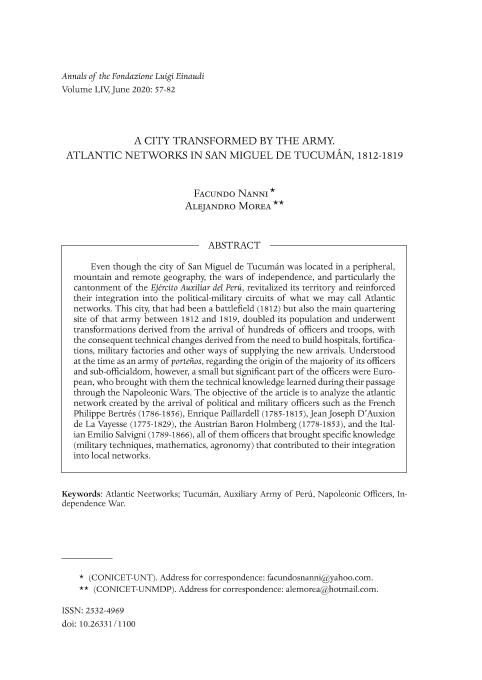Artículo
A city transformed by the army. Atlantic networks in the Ejército Auxiliar del Perú during its quartering in San Miguel de Tucumán: 1812-1819
Fecha de publicación:
01/2020
Editorial:
Olschki
Revista:
Annals of the Fondazione Luigi Einaudi
ISSN:
2532-4969
Idioma:
Inglés
Tipo de recurso:
Artículo publicado
Clasificación temática:
Resumen
Even though the city of San Miguel de Tucumán was located in a peripheral, mountain and remote geography, the wars of independence, and particularly the cantonment of the Ejército Auxiliar del Perú, revitalized its territory and reinforced their integration into the political-military circuits of what we may call Atlantic networks. This city, that had been a battlefield (1812) but also the main quartering site of that army between 1812 and 1819, doubled its population and underwent transformations derived from the arrival of hundreds of officers and troops, with the consequent technical changes derived from the need to build hospitals, fortifica- tions, military factories and other ways of supplying the new arrivals. Understood at the time as an army of porteños, regarding the origin of the majority of its officers and sub-officialdom, however, a small but significant part of the officers were Euro- pean, who brought with them the technical knowledge learned during their passage through the Napoleonic Wars. The objective of the article is to analyze the atlantic network created by the arrival of political and military officers such as the French Philippe Bertrés (1786-1856), Enrique Paillardell (1785-1815), Jean Joseph D?Auxion de La Vayesse (1775-1829), the Austrian Baron Holmberg (1778-1853), and the Ital- ian Emilio Salvigni (1789-1866), all of them officers that brought specific knowledge (military techniques, mathematics, agronomy) that contributed to their integration into local networks.
Palabras clave:
ATLANTIC NETWORKS
,
NAPOLEONIC OFFICERS
,
EJÉRCITO AUXILIAR DEL PERÚ
,
TUCUMÁN
Archivos asociados
Licencia
Identificadores
Colecciones
Articulos(INHUS)
Articulos de INSTITUTO DE HUMANIDADES Y CIENCIAS SOCIALES
Articulos de INSTITUTO DE HUMANIDADES Y CIENCIAS SOCIALES
Citación
Nanni, Facundo; Morea, Alejandro Hernán; A city transformed by the army. Atlantic networks in the Ejército Auxiliar del Perú during its quartering in San Miguel de Tucumán: 1812-1819; Olschki; Annals of the Fondazione Luigi Einaudi; XVI; 1-2020; 57-82
Compartir
Altmétricas




